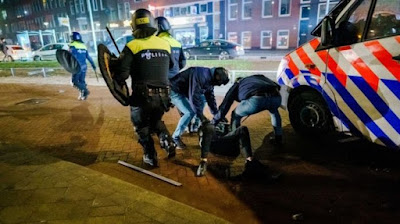Where and why are people protesting lock downs?
 |
| Violent protests in the Netherlands recently |
Around the world since the pandemic began people have been protesting the lock-downs? Why is this happening and what are the gals of the protestors?
As you know we have been in a lockdown or semi-lockdown state since last March, almost one year. As you are also probably aware, this fact has cost millions of people their jobs and their businesses. World-wide poverty has increased and disparities between the wealthy and ordinary people has increased dramatically. This has caused unrest in many places in world. Most recently in the Netherlands, a normally very law-abiding place, there have been widespread protests over the last weekend against a curfew that goes into effect after 9 PM. People disobeying the curfew are fined $100. During the protests at least 3,600 people were fined and after the initial protests, some teens attacked and looted stores. The police used water cannons on the protestors and the government said it would not tolerate further protests. In Denmark protests against lockdowns also broke out and an effigy ro life-size doll of the female prime minister was burned and a sign on the dummy said the prime minister should be killed. Similar demonstrations have broken out around the world, from Latin America to Africa, including in the United States last summer.
According to experts, the protests are of three main varieties:
The first are libertarian “pro-citizen” movements which have occurred primarily in developed countries of the West, where participants have taken issue with governments restricting their personal freedoms. These attract large crowds– an example being the August 29 protest in Germany, when 38,000 protested in front of the national parliament in Berlin.
The second type is seen taking place in developing economies with large informal sectors, where agitators target the impact of lockdowns on their livelihoods. Such protests were seen in Mexico, South Africa and Belgium, where hospitality and retail workers protested against limitations on in-person activities.
The third kind of protests are those objecting to how the lockdown restrictions are being enforced, accusing authorities of acting arbitrarily or of using excessive force. In China’s Xinjiang province, home to the persecuted Uighur ethnic minority, there have been online protests in which social media users have described the allegedly cruel measures imposed during the lockdown. (Explained: Why are there protests in Europe over new Covid-19 lockdowns?)







No comments:
Post a Comment